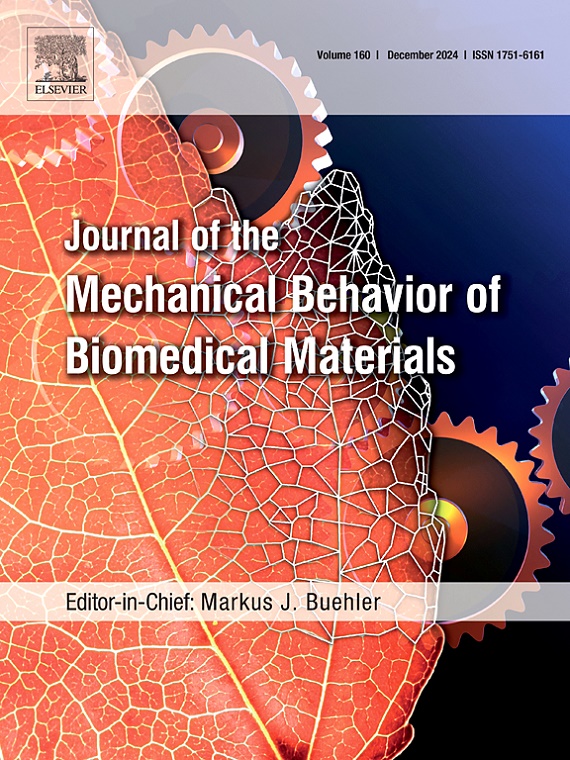Accurate measurement of a bone surrogate flexural rigidity in three- and four-point bending
IF 3.3
2区 医学
Q2 ENGINEERING, BIOMEDICAL
Journal of the Mechanical Behavior of Biomedical Materials
Pub Date : 2025-03-28
DOI:10.1016/j.jmbbm.2025.106986
引用次数: 0
Abstract
The mechanical assessment of long bones through bending is an established preclinical approach to evaluate the effectiveness of treatments for osteoporosis and fractures. Three- and four-point bending (3PB and 4PB) tests are the most common methods for mechanical characterization of long bones with Euler-Bernoulli (EB) theory to calculate of bone flexural rigidity (EI). Previous studies demonstrated that EB theory underestimates the EI of long bones due to its reliance on assumptions that are not entirely applicable to long bones. Therefore, the current study aimed to evaluate the factors that affect the percent error (PE) and bias stemming from the omission of contact and shear deflections in the EI estimation using mechanical testing and finite element analysis (FEA). The true EI of a porcine bone surrogate was used to quantify the percent error and bias of EI estimations from three deflection measurement methods and FEA, in 3PB and 4PB. The analysis confirmed that bending was the main component of total deflection, but only contributed to approximately 50 % and 65 % of the total deflection in 3PB and 4PB, respectively. The combined shear and indentation deflections accounted for the remainder of the total deflection. The FEA aligned with 3PB and 4PB tests with less than 10 % deviation. Underestimation of EI was largest with deflection measurements taken from the machine crosshead (PE 74 % in 3PB and 71 % in 4PB). However, these underestimations improved notably when indentation and shear deflections were considered (PE 42 % in 3PB and 39 % in 4PB). The deflection measurements from extensometer and digital image correlation (DIC) underestimated the EI by 66 % and 71 % in 3PB, and 57 % and 59 % in 4PB. When corrected for shear and indentation deflections, the 3PB PE reduced to 16 % and 14 %, respectively. In 4PB, PE reduced to, 10 % and 7 %, respectively, demonstrating the advantage of the 4PB test configuration over 3PB. The bias resulting from shear deflection was not consistent across deflection measurement methods; and therefore, cannot be generalized with a constant bias correction. The current study highlighted that a slight error in deflection measurement can lead to a significant inaccuracy in EI measurements. This sensitivity comes from the hyperbolic relationship between EI and deflection which not only depends on the ratio of support span to diameter of the specimen but also the test configuration and the ratio of the elastic to shear modulus of specimen. In other words, the PE from neglecting shear effects increases as the specimen EI increases. Accuracy with less than 10 % PE in EI estimations can be achieved by: 1. taking deflection measurements with extensometers, DIC, or FEA; 2. testing in 4PB instead of 3PB; and, 3. correcting for indentation and shear deflections.

求助全文
约1分钟内获得全文
求助全文
来源期刊

Journal of the Mechanical Behavior of Biomedical Materials
工程技术-材料科学:生物材料
CiteScore
7.20
自引率
7.70%
发文量
505
审稿时长
46 days
期刊介绍:
The Journal of the Mechanical Behavior of Biomedical Materials is concerned with the mechanical deformation, damage and failure under applied forces, of biological material (at the tissue, cellular and molecular levels) and of biomaterials, i.e. those materials which are designed to mimic or replace biological materials.
The primary focus of the journal is the synthesis of materials science, biology, and medical and dental science. Reports of fundamental scientific investigations are welcome, as are articles concerned with the practical application of materials in medical devices. Both experimental and theoretical work is of interest; theoretical papers will normally include comparison of predictions with experimental data, though we recognize that this may not always be appropriate. The journal also publishes technical notes concerned with emerging experimental or theoretical techniques, letters to the editor and, by invitation, review articles and papers describing existing techniques for the benefit of an interdisciplinary readership.
 求助内容:
求助内容: 应助结果提醒方式:
应助结果提醒方式:


